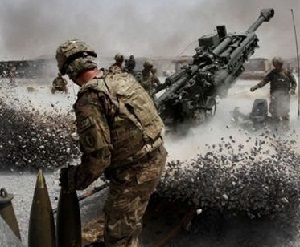 On January 19, 2018, U.S. Secretary of Defense James Mattis presented in Washington the declassified version of the United States’ National Defense Strategy. In his speech, he made clear the militaristic approach that will be maintained in coming years: “This strategy expands our competitive space, prioritizes preparedness for war.”
On January 19, 2018, U.S. Secretary of Defense James Mattis presented in Washington the declassified version of the United States’ National Defense Strategy. In his speech, he made clear the militaristic approach that will be maintained in coming years: “This strategy expands our competitive space, prioritizes preparedness for war.”
According to Mattis, the fight against terrorism will continue, “but Great Power competition, not terrorism, is now the primary focus of U.S. national security,” which means a readjustment of the approach since the attacks of September 11, 2001. In line with the National Security Strategy of December 2017, Russia and China are identified as the main threats to the U.S. On a second level, are the Democratic People’s Republic of Korea and Iran, and the most dangerous non-state actor is identified as the Islamic State.
The document notes, “The 2018 National Defense Strategy underpins our planned fiscal year 2019-2023 budgets, accelerating our modernization programs and devoting additional resources in a sustained effort to solidify our competitive advantage.” In this sense, the U.S. will prioritize nuclear modernization, and investments in cyber and missile defense.
This the first time, in more than 15 years, that the U.S. has explicitly stated its interest in increasing military spending to maintain superiority over Russia and China, and consolidate its global hegemony. During this period, international terrorism served as the pretext for the strengthening of U.S. military forces, since after the fall of the Soviet Union and the socialist camp, the supposed threat that led the United States to exponentially increase its military budget after WWII, to the benefit of influential corporations, disappeared.
The language used recalls the Cold War era East-West conflict. The greatest exponent of the arms race was President Ronald Reagan, who in 1983 publicly launched the Strategic Defense Initiative, in which the scientific community was asked to develop a missile defense system to guarantee the protection of U.S. territory against a nuclear attack. It was also known as “Star Wars,” like the famous film of the time. As was shown that on that occasion, the only winner was “the Military-Industrial Complex.”
The current Strategy also reaffirms that the use of force will be applied as a foreign policy principle: “Reinforcing America’s traditional tools of diplomacy, the Department provides military options to ensure the President and our diplomats negotiate from a position of strength.” In addition, it is noted that states are the main actors on the global scene, but that non-state actors, such as terrorists, transnational criminal organizations, and hackers, “also threaten the security environment with increasingly sophisticated capabilities.”
The document emphasizes that the new strategy “articulates our strategy to compete, deter, and win” in this increasingly complex environment, stressing, “The costs of not implementing this strategy are clear. Failure to meet our defense objectives will result in decreasing U.S. global influence, eroding cohesion among allies and partners, and reduced access to markets that will contribute to a decline in our prosperity and standard of living.”
It is noted: “A long-term strategic competition requires the seamless integration of multiple elements of national power – diplomacy, information, economics, finance, intelligence, law enforcement, and military,” continuing: “More than any other nation, America can expand the competitive space, seizing the initiative to challenge our competitors where we possess advantages and they lack strength.” At the same time, it is claimed the U.S. “is open to opportunities for cooperation but from a position of strength and based on our national interests.”
Latin America and the Caribbean are mentioned only twice, referring to the Western Hemisphere, and unlike the Strategy of December 2017, no specific country of the region is mentioned. The objectives of the Strategy include “maintaining favorable regional balances of power in the Indo-Pacific, Europe, the Middle East, and the Western Hemisphere.”
As outlined, the U.S. will deepen its relations with Latin American and Caribbean countries that “contribute military capabilities to shared regional and global security challenges.” The document also notes, “The U.S. derives immense benefit from a stable, peaceful hemisphere that reduces security threats to the homeland.”
Although not recognized in the Strategy, it is worth mentioning that Latin America and the Caribbean is the most densely populated area in the world, and that more than half a century ago, it was declared a nuclear-weapon-free zone, through the Treaty of Tlatelolco. Last month marked four years since the 33 member countries of the Community of Latin American and Caribbean States (CELAC), meeting at their Second Summit, in Havana January 28-29, 2014, declared “Latin America and the Caribbean as a Zone of Peace.”
This is the “civilized” world of the 21st century – some proclaim peace while others enact war. The Pentagon has revealed it is committed to building “a more lethal force,” in clear defiance of international peace, and to justify its 700 billion dollar military budget for 2018.
The Strategy defends President Donald Trump’s nationalist electoral platform of “America first,” which combines diplomatic isolationism and economic protectionism, with military reinforcement and the denial of the threat of climate change. A “novel” formula to try to maintain global hegemony, and another “good deal” for the Military-Industrial Complex.
2016 NATO spending by country with percentage of total
In millions of dollars
U.S. 72.36% – $664.058
UK 6.5% – $60.347
France 4.7% – $43.620
Germany 4.4% – $40.663
Italy 2.3% – $21.878
Canada 1.6% – $15.395
Turkey 1.2% – $11.573
Spain 1.2% – $11.064
Others 5.4% – $49.698
(Granma)